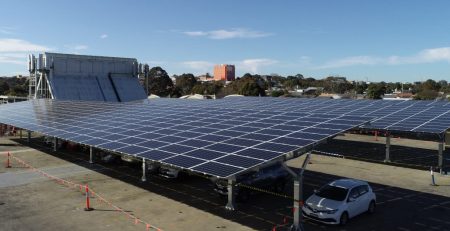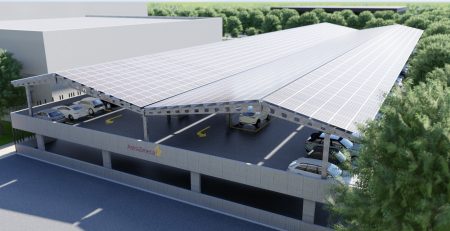Solar Potential of Untapped Urban Areas Grows as Low Carbon Targets Loom
GREEN REVIEW : August 2024 (www.greenreview.com.au)
Kapitol Group ushers sustainable progress in construction
Battery storage transforming energy management for businesses
Australia’s wind energy revolution — from land to sea
Reducing steel emissions an inevitable passage as global market shifts
Solar Potential of Untapped Urban Areas Grows as Low Carbon Targets Loom
Substantial underutilised car parks offer immense opportunities to integrate solar PV systems, enabling increased renewable energy production, solar shading, and electric vehicle charging.
Over the last two decades, rooftop solar photovoltaic (PV) systems have become one of the most costeffective renewable energy technologies to be applied in densely populated urban areas.
While it is becoming increasingly more common to install these systems in cities, there are still challenges in deploying them at scale in urban areas due to density, and the orientation and the architectural configuration of these areas.
On the other hand, open car parks, which commonly cover enormous spaces within cities and urban areas, have higher flexibility and can accommodate structures that are optimally designed to integrate PV for higher energy yields.
These car parks are normally located in close proximity to workplaces, shopping centres, or airports and often frequented by a large number of people.
As such, car parks with shading structures can better protect people and vehicles from various weather conditions, providing vehicles with pre-cooling, which can effectively reduce energy consumption.
These structures also provide additional opportunities, for instance in utilising the electricity generated for local energy demand, including charging EVs.
A study published in the Energies journal, found that large-scale PV deployment in untapped car parking areas, which are estimated to represent up to 6.6 per cent of the urban footprint within cities, could have power outputs that are as large as PV installations in buildings, and provide another pathway for cities to achieve low carbon targets.
The study findings were underpinned by a university campus case study, with a car park footprint similar to those in cities, and demonstrated that less than 1 per cent of the available parking spaces were affected by shadows from surrounding buildings or vegetation.
Car parks have not been systematically utilised for PV deployment, but in recent years they have become increasingly more recognised for their huge potential in energy production.
In July 2023, France made it mandatory to install solar panels on parking lots containing 80 to 400 spaces, with compliance needed to be achieved within five years. Car parks exceeding 400 spaces must reach that goal within three years.
By 1 July 2026, all outdoor car parks with a surface area greater than 10,000 square metres and car parks with a surface area of between 1,500 and 10,000 square metres must be covered by 50 per cent with solar panels.
According to the French government, the photovoltaic parking lots could generate approximately nine to eleven gigawatts of energy, nearly as much as 10 nuclear reactors.
Another aspect of the French mandate is that by 1 January 2025, non-residential buildings with a car park of more than 20 spaces must have electric vehicle charging stations.
Car park solar installations that are equipped with EV charging can complement each other with the solar generated enabling on-site charging of EVs, offering both convenience and incentive for businesses, employees, visitors and customers.
According to a 2020 report by the ACT government, approximately 80 per cent of prospective customers were projected to install electric vehicle charge points with their solar car park systems.
While Australia has not yet introduced legislation to scale up solar car parks, installations are still growing in both number and size.
Australia’s largest car park solar installation is located in South Australia, with 1,400 solar shaded car spaces at Elizabeth City Centre. More than 12,000 solar panels have been installed, covering approximately 22,000 square metres.
The projected annual renewable energy generation is more than 11.5 gigawatt hours – enough to power more than 2,000 average homes for a year.
Experts in Solar Car Park Solutions
Solar Car Parks was established in Australia in 2019, but its popularity has notably increased over the past year or so.
This surge in popularity can be attributed to several factors:
- Increasing demand for electric vehicle (EV) chargers, necessitating more onsite clean energy generation.
- Recognition that rooftop solar alone may not suffice to meet the energy demands of sites.
- Growing demand for shaded parking to cool vehicles and mitigate the “heat island” effect.
Discover why Solar Car Parks is the industry leader in solar structure design!
With unmatched experience on over 100 operational carparks, we excel in crafting unique designs that cater to your site’s specific needs.
Whether you require standard structures for individual car spaces or expansive “solar roofs” that cover entire car parks, we specialise in designing and installing solutions
that perfectly fit your requirements.
Trust Solar Car Parks for innovative solar solutions tailored just for you!
Contact us to see what could be done to modernise your car park
T: 1300 545 229
hello@solarcarparks.com.au
www.solarcarparks.com.au
https://www.solarcarparks.com.au/wp-content/uploads/2024/08/AUGUST2024.pdf
Solar carparks have installed a variety of different systems types and sizes over the last six months some images of these are below.














Leave a Reply